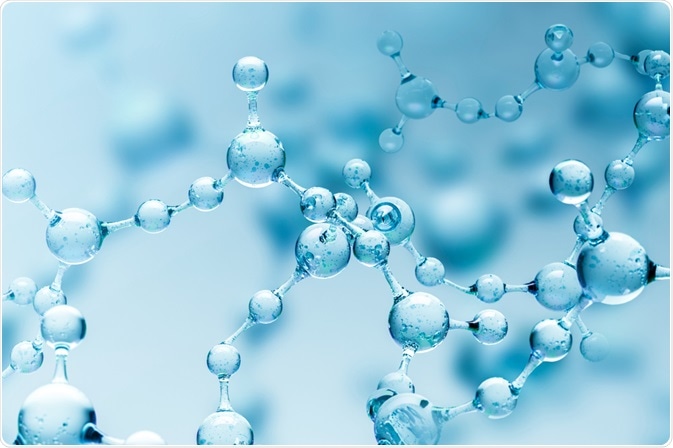NMR makes use of specific stable isotopes, commonly 13C, but there is only one NMR-active stable isotope for oxygen, 17O. The effects of using this oxygen isotope over other isotopes include lower NMR receptivity, a nonzero quadrupole moment, and a larger chemical shift range compared to many other isotopes.
Skip to:
- What are the Applications of 17O NMR Spectroscopy?
- What are the Benefits of 17O NMR Spectroscopy?
- What are the Limitations of Oxygen Isotope NMR?
 Image Credit: ImageFlow / Shutterstock.com
Image Credit: ImageFlow / Shutterstock.com
What are the Applications of 17O NMR Spectroscopy?
NMR with the oxygen isotope has several applications in biology, many of which exploit the role of oxygen in combination with other compounds such as iron. For example, one of the first applications was of protein and ligand interactions of isotope-labeled molecules binding to ferrous heme proteins.
Further work has looked at protein structure. By labeling positions on the side chain of superoxide anion with 17O2 as an oxidant, the structure of the protein CuZn superoxide dismutase (SOD1) could be revealed, as the function of the protein is to prevent oxidative aggression towards cells by oxidizing superoxide anion.
Clear differences are visible in the protein structure depending on the state of the copper molecule in SOD1, which indicates environmental and dynamic differences could be affecting its structure.
As with most types of NMR, 17O NMR spectroscopy is also showing promise in metabolomics. Labeling rat hearts with oxygen isotopes and analyzing these dynamically with NMR spectroscopy revealed a gradual increase in H217O, produced by heart metabolism. In turn, this peak could be used to infer the rate of consumption of 17O2 in heart muscle cells.
What are the Benefits of 17O NMR Spectroscopy?
One of the biggest advantages of oxygen isotope NMR comes from using oxygen. Oxygen is a highly abundant and variable molecule, present in many critical biomolecules and highly relevant to biochemical reactions. The ability to target oxygen atoms allows for the characterization of both the molecule itself and the structures and reactions it is part of.
While the quadrupolar nucleus of oxygen can be a limiting factor, it does make oxygen NMR more sensitive to local oxygen environments. The nucleus is also sensitive to anisotropic NMR interactions. In turn, this allows anisotropic interactions to be used to yield three-dimensional structural information. Included in this is valuable information about networks of hydrogen bonds and interactions between ions and oxygen.
With small molecules in solution, fast molecular tumbling leads to averaging of the quadrupolar interaction and therefore thinner isotropic lines. For practical applications, this means that 17O NMR, when applied to solutions, is a valuable tool in showing the structure of small organic molecules.
What are the Limitations of Oxygen Isotope NMR?
While oxygen is a highly variable and widespread atom, the isotope available for NMR spectroscopy is not. Furthermore, the nucleus of the only NMR active isotope is not particularly well suited to NMR due to its large quadrupole moment and quadrupolar spin, resulting in a big electric field gradient.
Its low natural occurrence also contributes to decreased sensitivity and complicated spectra, which can make its application difficult by further exacerbating already present issues with NMR. This remains true even under magic angle spinning (MAS).
While appropriate for small molecules, oxygen NMR is less applicable for understanding structural information about larger biomolecules. This is due to slower tumbling while in solution, which results in quick quadrupole transverse relaxation and massive broadening of the lines of 17O NMR signals.
While application to larger biomolecules has been limited, some researchers have shown that it can be viable.
Sources
- Castiglione F., et al. (2015). 17O NMR: a ‘rare and sensitive’ probe of molecular interactions and dynamics. Annual Report on NMR Spectroscopy. https://doi.org/10.1016/bs.arnmr.2014.12.004
- Wong A. and Poli F (2014). Solid-state 17O NMR studies of biomolecules. Annual Reports on NMR Spectroscopy. https://doi.org/10.1016/B978-0-12-800183-7.00003-4
- Wong A., et al. (2006). New limits for solid-state 17O NMR spectroscopy: complete resolution of multiple oxygen sites in a simple biomolecule. Journal of the American Chemical Society. https://doi.org/10.1021/ja062031l
Further Reading
- All Nuclear Magnetic Resonance (NMR) Content
- Future of NMR Spectroscopy
- NMR in Cancer Research: An Overview
- Applications of In-Cell NMR
- NMR-Based Metabolomics
Last Updated: Oct 31, 2019

Written by
Sara Ryding
Sara is a passionate life sciences writer who specializes in zoology and ornithology. She is currently completing a Ph.D. at Deakin University in Australia which focuses on how the beaks of birds change with global warming.
Source: Read Full Article



